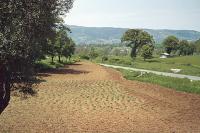Reference soil Italy 03: Alisol
Alisols occur in the tropics and subtropics, and in the warm temperate regions of the world in relatively young landscapes. The high level of exchangeable aluminium in these soils is caused by rapid weathering of secondary high-activity clays such as vermiculite and smectite.
Characteristics
Soils having an argic horizon (a subsurface horizon with distinct higher clay content than the overlying horizon), which has a cation exchange capacity of 24 cmolc per kg clay or more, and which starts either within 100 cm from the soil surface, or within 200 cm from the soil surface if the argic horizon is overlain by loamy sand or coarser textures throughout. They have "alic" properties (high content of exchangeable aluminium) in the major part between 25 and 100 cm from the soil surface; moreover, only such diagnostic horizons as an ochric, albic, andic, ferric, nitic, plinthic, or vertic horizon are present.
Reference soil IT003:
Short field description: A very deep, moderately well to well drained, dark reddish brown loamy clayey soil; the thin loamy A-horizon is underlain by a clayey loam B. It changes in a homogeneousdark reddish brown clay with a strong coarse prismatic structure, breaking into angular blocky peds. The pH(water) is neutral in the B, becoming strongly to medium acid in the lower part of the solum. The (A) and (B) horizon are strongly affected by anthrogenic influence. The 2B21t and 2B22t horizon contain patchy blackish Mn cutans. Soils of this nature were observed in the Upper Crati basin, but may also occur downstreams, and do probaly also occur in other areas in the mediterranean region. The land is mainly used for grazing, and occasionally as dwelling site. The pH is determined conform Hellige. * The effective soil depth is more than 1.6m.; no evidence of groundwater is found within 2m.
